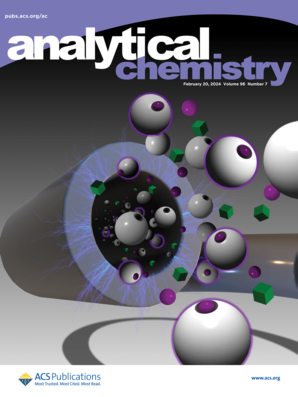Mechanistic Study of the Deuterium Effect in Chromatographic Separation for Chemical-Tagging Metabolomics and Its Application to Biomarker Discovery in Metabolic Dysfunction-Associated Steatohepatitis
IF 6.7
1区 化学
Q1 CHEMISTRY, ANALYTICAL
引用次数: 0
Abstract
Over the past decade, numerous metabolomics techniques have been developed using liquid chromatography–mass spectrometry (LC-MS). These methodologies have yielded significant findings and facilitated the identification of biomarkers. Among these, chemical-tagging methodologies combined with isotope surrogate tags have garnered considerable attention as a leading approach. Chemical-tagging reduces labor and costs by eliminating the need for internal standard preparation. However, the chromatographic deuterium effect (CDE) has persisted as a significant challenge. CDE poses a risk of data misinterpretation in metabolomics due to potential differences in matrix effects. Although the CDE mechanism has been partially elucidated, it has primarily been attributed to differences in hydrophobicity. A detailed understanding of CDE mechanisms would be valuable for designing chemical tags and optimizing liquid chromatography (LC) conditions. Moreover, emphasizing the CDE could aid in the separation and purification of deuterated compounds. In this study, we investigated the mechanistic basis of the CDE. Initially, four chromatography columns with different separation modes─octadecyl, octadecyl with a positively charged surface, biphenyl, and pentafluorophenyl (PFP) groups─were evaluated based on retention differences between 1H- and 2H6-labeled chemically tagged metabolites. Among these, the PFP column demonstrated the most effective reduction of the CDE, suggesting that electronic interactions with fluorine stabilized 2H-labeled metabolites. Further optimization using the PFP column showed its efficacy in reducing the level of CDE in human serum samples. Finally, the optimized approach was successfully applied to global metabolomics analysis of serum from a mouse model of metabolic dysfunction-associated steatohepatitis.

化学标记代谢组学色谱分离中氘效应的机制研究及其在代谢功能障碍相关脂肪性肝炎生物标志物发现中的应用
在过去的十年中,许多代谢组学技术已经发展到使用液相色谱-质谱(LC-MS)。这些方法已经产生了重要的发现,并促进了生物标志物的鉴定。其中,化学标记方法与同位素替代标签相结合,作为一种领先的方法已经引起了相当大的关注。化学标签通过消除内部标准制备的需要,减少了劳动力和成本。然而,色谱氘效应(CDE)一直是一个重大的挑战。由于基质效应的潜在差异,CDE在代谢组学中存在数据误读的风险。虽然CDE的机制已部分阐明,但主要归因于疏水性的差异。对CDE机制的详细了解将有助于设计化学标签和优化液相色谱(LC)条件。此外,强调CDE有助于氘化化合物的分离和纯化。在这项研究中,我们探讨了CDE的机制基础。首先,采用不同分离模式的四种色谱柱──十八烷基、表面带正电荷的十八烷基、联苯和五氟苯基(PFP)基团──根据1H-和2h6标记的化学标记代谢物之间的保留差异进行了评估。其中,PFP柱显示出最有效的CDE还原,表明与氟稳定的2h标记代谢物的电子相互作用。进一步优化后的PFP柱显示了其降低人血清样品中CDE水平的效果。最后,将优化的方法成功应用于代谢功能障碍相关脂肪性肝炎小鼠模型血清的整体代谢组学分析。
本文章由计算机程序翻译,如有差异,请以英文原文为准。
求助全文
约1分钟内获得全文
求助全文
来源期刊

Analytical Chemistry
化学-分析化学
CiteScore
12.10
自引率
12.20%
发文量
1949
审稿时长
1.4 months
期刊介绍:
Analytical Chemistry, a peer-reviewed research journal, focuses on disseminating new and original knowledge across all branches of analytical chemistry. Fundamental articles may explore general principles of chemical measurement science and need not directly address existing or potential analytical methodology. They can be entirely theoretical or report experimental results. Contributions may cover various phases of analytical operations, including sampling, bioanalysis, electrochemistry, mass spectrometry, microscale and nanoscale systems, environmental analysis, separations, spectroscopy, chemical reactions and selectivity, instrumentation, imaging, surface analysis, and data processing. Papers discussing known analytical methods should present a significant, original application of the method, a notable improvement, or results on an important analyte.
 求助内容:
求助内容: 应助结果提醒方式:
应助结果提醒方式:


